New Kahului Airport Rent-A-Car center completed on time and on budget
Posted on May 14, 2019 in Airports News, Main, NewsThe LEED Silver certified, environmentally friendly facility and electric tram open to the public May 15
KAHULUI – The Hawaii Department of Transportation (HDOT) is thrilled to announce the completion of the environmentally friendly Consolidated Rent-A-Car (Conrac) facility at Kahului Airport (OGG), which will open to the public beginning Wednesday, May 15, 2019. The Conrac will house the major rent-a-car companies in one convenient location on airport property.
“The people of Hawaii can be proud of this project as it is good for Mother Earth, while also adding efficiency and beauty to Kahului Airport,” said Gov. David Ige. “We continue to modernize our airports around the state and people will continue to see smart and sustainable improvements being completed over the next two years.”
The new Conrac is a three-level structure encompassing rental car offices, customer service counters, ready and return rental car spaces, and Quick-Turn-Around (QTA) areas with 72 fuel positions, 12 car wash bays and 11 maintenance and mechanic stations to service rental car fleets. There will be more than 3,700 parking stalls dedicated to the rental car companies plus nearly 700 for employee parking.
The Conrac has officially been certified Leadership in Energy and Environmental Design (LEED) Silver for its work to maximize the health and productivity for those who use the facility, use fewer resources, reduce waste and help the environment through reducing negative impacts on the planet. LEED is the most widely recognized green building certification program in the world. It offers third-party verification and leads to higher performing buildings than non-certified buildings.
The facility features an electric tram built on a rail system to provide quick and efficient travel between the airport terminal and rental car counters, which is about half a mile in length. The tram was designed to reflect the Valley Isle’s plantation roots, culture and history. The tram will help relieve congestion around the airport by eliminating the need for 25 shuttle buses to transport customers to various locations, an average of 85 trips an hour. The facility will help the environment by taking the fossil fueled buses off the roadway and reducing our carbon footprint. It is also powered by solar panels located throughout the airport property. Additional tram facts can be found below.
The new Conrac incorporates natural beauty found throughout the island of Maui and will help make a positive first and last impression with guests. HDOT had previously opened a new airport access road that extends from the Hana Highway to the Airport Loop Road which relieves congestion on the surrounding roadways. The road is lined with palm trees and native landscaping to provide a scenic route to the terminal. All lanes opened in October 2018.
The project includes a water feature that is both beautiful and functional. The cascading waterfalls and shimmering pools greet people as they enter the property. It also serves as an irrigation reservoir with non-potable water for landscaped areas. The reservoir contains nearly 140,000 gallons of non-potable water. The water is filtered to eliminate particles and will prevent clogging the system. The reservoir also means more potable water will be available for the community.
“Kahului is the second busiest airport in the state and the people of Maui deserve a facility of this caliber. Our team found a way to add functional beauty to the project without adding to the cost,” said Deputy Director Ross Higashi, Hawaii Department of Transportation. “I am proud of this project and everyone who worked to build it on time and on budget.”
Construction broke ground on April 15, 2016 with a total cost of $340 million, funded solely by a Customer Facility Charge which consists of a daily charge of $4.50 applied to customers who rent a car. No taxpayer funds were used.
The lead contractor is Hawaiian Dredging Construction Company, Inc. The design team is led by Demattei Wong Architects. The project employed more than 200 people on site and created 500 additional jobs in the industry.
Kahului Airport served more than seven million total passengers in 2018. OGG contributes more than $24 million annually in rental car customer facility charges, more than any other airport in the state.
The companies that will operate at the new facility include Advantage, Alamo, Avis, Budget, Dollar, Enterprise, EZ, Firefly, Hertz, National, Payless, Thrifty and Zipcar.
Conrac facts:
- 8 million cubic square feet of concrete poured
- Quick-Turn-Around area features 12 car wash bays, 11 mechanic stations and 72 fuel positions.
- 1,817 ready/return parking stalls
- 1,926 staging/storage parking stalls
- 693 airport employee parking stalls
- 4,436 total parking stalls in the Conrac
- 2 tanks each with 25,000-gallon capacity of foam fire solution
- 8 tanks each with 1,000-gallon capacity to catch fuel/oil/fluids which will run through a separator and cleaned which is good for the environment and prevents runoff to the ocean
Electric tram facts:
- The tram was manufactured in Sweden and assembled in San Jose, California by Schwager Davis, Inc.
- There will be two trams with two cars
- Each car can carry 38 people with luggage
- Both trains will operate simultaneously during peak hours of operation with one operating in non-peak hours
- Each tram will have an operator on board during operational hours
- The tram will close between 11 p.m. to 5 a.m. nightly, unless there are flight delays or other factors that would warrant extending operating hours
- The tram has three stops along the half mile route with two stops at the airport terminal and one at the Conrac rental counters
- It will take approximately six minutes to go round trip from end to end
- The wheels are called bogeys
LEED Silver certification highlights:
- Offset 22% of total annual energy cost through campus renewable solar energy production
- Achieved a 22% energy cost savings for the project, as compared to an ASHRAE 90.1-2007 baseline
- Diverted 77% construction waste from the landfill, which equated to 11,150 tons of diverted materials
- Sourced 10% and 15%, by cost, of the overall construction materials with recycled content and locally regional materials (within 500 miles), respectively
- Sourced 96%, by cost, of all new wood-based materials on project to be FSC certified
- Utilized best practices for healthy indoor air quality by limiting the use of finish products that produce off-gas toxins, creating a healthy indoor environment for occupants.
- Achieved potable water use reduction for both indoor and outdoor uses:
- 45% reduction for plumbing fixtures, as compared to a baseline building, resulting in ~155,595 gallons potable water savings annually
- 63% reduction in potable water use for irrigation, as compared to the peak watering month, resulting in ~1,142,520 gallon/month potable water savings for the peak month
- Encouraged reduced GHG emissions by:
- Locating project within ¼ mile of bus station,
- Providing bike storage and showers for building users
- Reserving preferred parking spaces for car/vanpool and low-emitting fuel-efficient vehicles
- Reduced the heat island effect by installing lighter colored materials for both hardscape and roofing materials
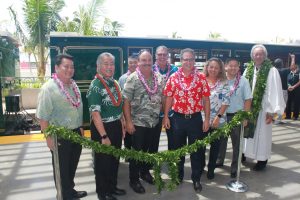
Rep. Kyle Yamashita (left to right); Governor David Ige; Sen. Rosalyn Baker (not pictured); HDOT Airports Division Deputy Director Ross Higashi; Kahului Airport Manager Marvin Moniz; Maui Mayor Mike Victorino; Senator J. Kalani English; Rep. Lynn DeCoite; Rep. Troy Hashimoto; and Kahu Kalani Wong participate in the blessing ceremony and untying of the maile lei for the new Kahului Airport Conrac.

Aerial view of the new Consolidated Rent-A-Car facility at the Kahului Airport. Photo Courtesy: Hawaii Department of Transportation or HDOT
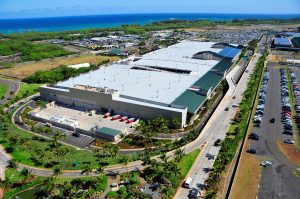
The new Conrac finished on time and on budget and opens to the public May 15, 2019.
Photo Courtesy: Hawaii Department of Transportation or HDOT
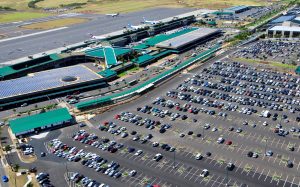
The electric tram route connects the main airport terminal to the Conrac. The solar panels located throughout the airport property help power the tram. Photo Courtesy: Hawaii Department of Transportation or HDOT
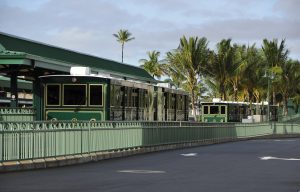
The facility features two free electric trams built on a rail system to provide quick and efficient travel between the airport terminal and rental car counters, which is about half a mile in length. Photo Courtesy: Hawaii Department of Transportation or HDOT

The tram was designed to reflect the Valley Isle’s plantation roots, culture and history. Photo Courtesy: Hawaii Department of Transportation or HDOT

The tram will help relieve congestion around the airport by eliminating the need for 25 shuttle buses to transport customers to various locations, an average of 85 trips an hour. Photo Courtesy: Hawaii Department of Transportation or HDOT
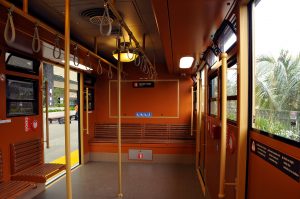
Each car can carry 38 people with luggage. Photo Courtesy: Hawaii Department of Transportation or HDOT
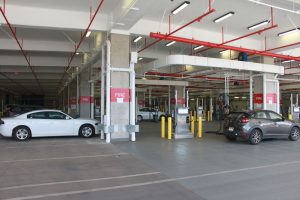
The new Conrac is a three-level structure featuring Quick-Turn-Around (QTA) areas with 72 fuel positions, 12 car wash bays and 11 maintenance and mechanic stations to service rental car fleets.
###

